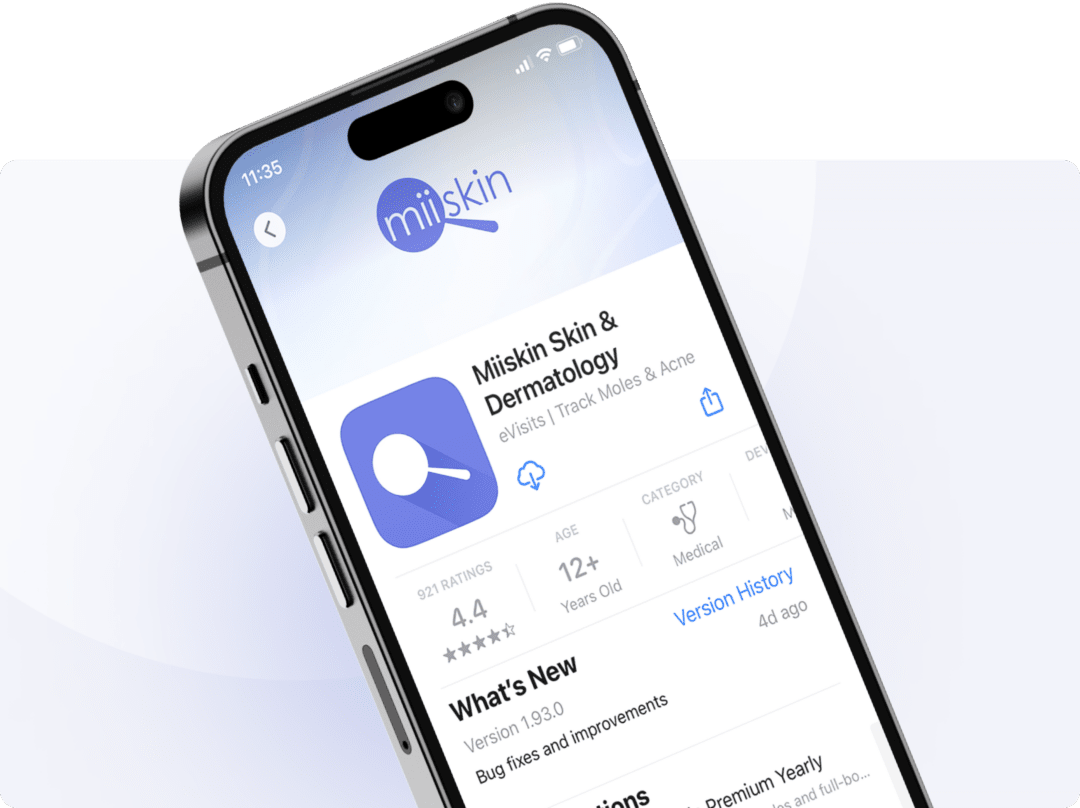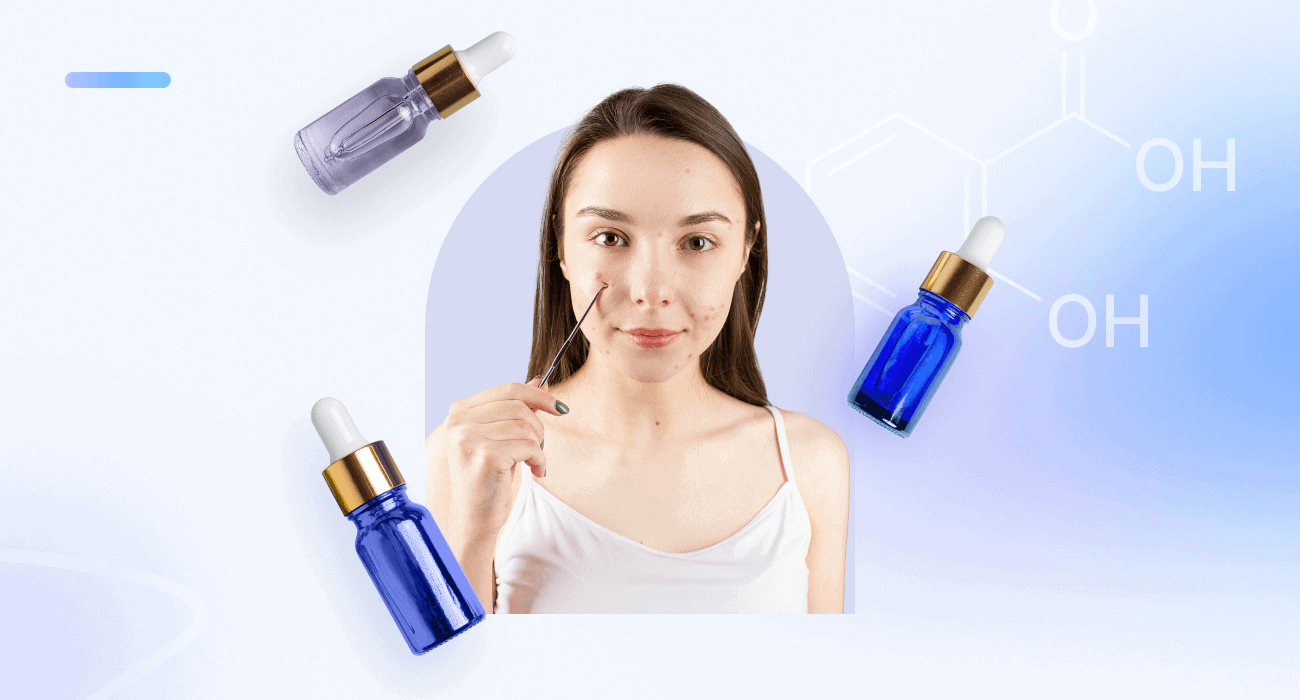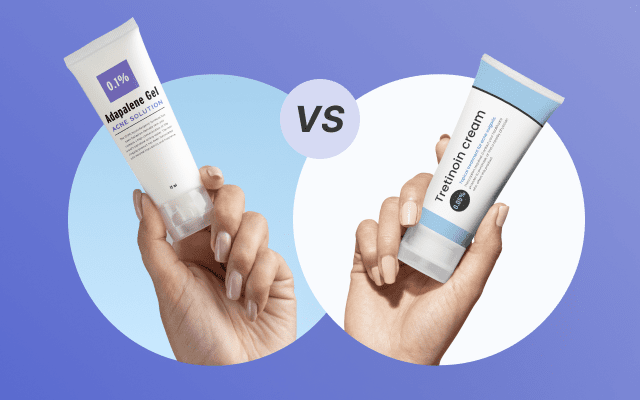Psoriasis on face: What is it and how to get rid of it?
Dr. Ben Williams, dermatologist, talks about psoriasis on the face, how to deal with flares, and how to get rid of its symptoms with the right treatment.
Contenido:
Can you get on the face? | Symptoms | Types of psoriasis | Similar conditions to psoriasis | Causes | Best treatment | Tips to manage a flare | Light therapy for psoriasis
Our commitment to producing high-quality content:
The information presented in this article is based on scientific research and the professional advice of our Content Medical Reviewers, who are experts in the field of Dermatology. How we write our content →
What is psoriasis on the face?
Facial psoriasis is characterized by one or more thickened, red, and dry patches on the face. Psoriasis is a skin condition that causes red, scaly patches covered in silver scales, it can affect any part of the body, but it most commonly appears on the elbows, knees, scalp, lower back and more rarely on the face. Since psoriasis is a chronic condition, it can persist for a lifetime but it often goes through periods of flare-ups and remission1.
Dr. Ben Williams, dermatologist, says that while there is no ‘magic bullet’ or cure for psoriasis, choosing the right treatment can decrease or even completely clear your symptoms. treatment may include topical creams, phototherapy (light therapy), oral medications, or injectable biologics that target specific aspects of the immune system.
It is important to work closely with a dermatologist in your area to develop a treatment plan that suits their specific needs and preferences.
Can you get psoriasis on the face?
Dr. Williams says that it is possible for psoriasis to develop on the face, although it is less common in this area compared to other parts of the body.
When psoriasis affects the face, it usually manifests as red, scaly patches on these areas:
- Forehead and hairline
- Cheeks and nose creases
- Around the eyes
- Around the lips
- Outer (usually behind) and inner ears
Symptoms of psoriasis on the face
The symptoms of psoriasis on the face can vary in appearance and severity, but they generally include:
- Red patches or plaques of skin, which can be particularly noticeable, especially if the affected areas are on the cheeks or forehead
- Silvery-white scales on the face and may be more apparent in areas like the eyebrows, around the nose, or on the scalp near the forehead
- Itching on the face
- Dryness leading to peeling or cracking
- Mild to moderate swelling
- Face lesions in various shapes, including round or oval, and may have well-defined borders2
Types of psoriasis on the face
Scalp psoriasis
Scalp psoriasis may appear as fine scaling (that may resemble dandruff) or as thick, crusted plaques that cover the entire scalp. This condition can also be mistaken for seborrheic dermatitis, as symptoms tend to be similar, however, scalp psoriasis seems “dry and powdery”, while seborrheic dermatitis tends to look “yellowish and greasy” and likely also effects the classic areas around eyebrows, nasolabial folds, and behind the ears3.
Plaque psoriasis
Plaque psoriasis is the most common type of psoriasis and it leads to the formation of thick, textured, scaly, and discolored patches on the skin’s surface. These patches can provoke sensations of itching or discomfort, often resembling a burning or stinging sensation4.
Sebopsoriasis
Sebopsoriasis is a mix of two skin problems seborrheic dermatitis and psoriasis, combining symptoms of both conditions. Healthcare providers use this term when they see a rash that looks like psoriasis in areas where seborrheic dermatitis usually occurs but they cannot clinically distinguish between the two or feel like there may be an actual overlap of them. Over time and with treatment, it usually becomes more clear which condition the patient actually has5.
Guttate psoriasis
Guttate psoriasis is a unique subtype of psoriasis, primarily associated with a preceding streptococcal infection (such as throat or perianal infections). It is more common in children and teenagers than adults. Individuals with this condition typically exhibit numerous small, tear-shaped lesions that generally respond favorably to treatments like topical applications and phototherapy6.
Are there other skin conditions with similar symptoms to facial psoriasis?
There are other skin conditions that may resemble psoriasis on the face. These conditions may also cause redness, rashes, flakes, and other symptoms that could be mistaken with psoriasis such as:
- Seborrheic dermatitis
- Rosacea
- Allergic contact dermatitis
- Atopic dermatitis (eczema)
- Pityriasis rosea
- Lupus
- Shingles
- Dermatomyositis
- Ringworm
- Intertrigo
- Lichen planus
What causes psoriasis on the face and body?
The exact cause of psoriasis is not fully understood, but it is believed to be related to an immune response where the immune system is ramped up from the body’s own endogenous factors which creates a more rapid turnover of otherwise normal skin cells, leading to the characteristic symptoms of psoriasis. It is also believed that individuals with psoriasis have a genetic predisposition for the condition, which means it commonly runs in families7.
Common triggers for psoriasis
The triggers for a psoriasis flare can vary from person to person, but common psoriasis triggers include:
Stress
Psychological stress is a well-known trigger for psoriasis flare-ups. High levels of stress can lead to an overactive immune response, which can exacerbate psoriasis symptoms8.
Infections
Certain infections, such as strep throat, can trigger guttate psoriasis in some individuals9. Skin injuries or trauma (koebnerizing phenomenon) can also lead to psoriasis lesions.
Medications
Some medications, including beta-blockers, lithium, steroids, and non-steroidal anti-inflammatory drugs (NSAIDs),may worsen or even trigger psoriasis10.
Weather
The symptoms of psoriasis may worsen in dry, cold weather or during the winter months. Conversely, some people experience improvement during sunny, warm weather due to the beneficial effects of sunlight.
Alcohol
Excessive alcohol consumption has been associated with an increased risk of psoriasis and can exacerbate symptoms in those with the condition11.
Smoking
Smoking has been linked to a higher risk of developing psoriasis, and it can also make existing psoriasis worse12.
Obesity
Being overweight or obese is a risk factor for psoriasis and can make the condition more challenging to manage13.
Skin injuries
Physical injury to the skin, such as cuts, burns, or friction, can trigger psoriasis lesions in some individuals14.
What is the best psoriasis treatment for the face?
Since psoriasis is a chronic condition, a dermatologist should make a diagnosis and determine the best treatment for you as it will depend on the severity of your condition, your symptoms and medical history.
Learn more about the best psoriasis medications.
Tips to manage a flare up of psoriasis on the face
Seek guidance from a dermatologist since they can provide personalized advice and treatment options tailored to your specific condition.
However, here are some tips from Dr. Williams to help you manage facial psoriasis flare-ups more effectively.
- Using a gentle skin cleanser with salicylic acid (2% or higher) several times per week or when scaling is noticeable helps mildly exfoliate the skin.
- Keep your skin well-hydrated by applying a moisturizer daily. Choose fragrance-free, hypoallergenic products to avoid skin irritation. When you are flaring or begin to see redness / flaking in areas, replace your moisturizer step with a topical prescription strength medication as prescribed and recommended by your dermatologist. Dermatologists usually prescribe a combination of either mild topical steroids used in combination with calcipotriene which is a vitamin D analog as well as topical calcineurin inhibitors such as tacrolimus. Practice stress-reduction techniques such as deep breathing, meditation, yoga, or progressive muscle relaxation. High stress levels can exacerbate psoriasis symptoms.
- Maintaining a healthy lifestyle, eating a balanced diet rich in fruits, vegetables, or more simply put the Mediterranean diet that is rich in omega-3 fatty acids may be beneficial for psoriasis. Exercise regularly to help manage stress and improve overall well-being.
- Reduce your alcohol intake and stop smoking
- Use sunscreen in general; however, there may be some benefit while flaring to get natural sunlight for ~ 10-15 minutes per day. However, apply sunscreen to non-psoriasis areas and everywhere after that timeframe is exceeded.
- There may be some benefit from taking a daily vitamin D supplement as recommended by your primary care doctor.
- Stay in regular contact with your healthcare provider to monitor your condition’s progress and make necessary adjustments to your treatment plan.
Can you use light therapy (phototherapy) for the treatment of psoriasis on the face?
Phototherapy can be used to treat psoriasis on the face, but it requires careful consideration and professional supervision. Special eye protection is essential to shield the eyes from UV radiation during treatment.
The choice of the appropriate light source, dosage, and duration is determined by a dermatologist based on the severity of the condition. Regular monitoring is necessary to assess progress and adjust the treatment plan as needed.
Phototherapy may be combined with topical treatments for enhanced effectiveness. A consultation with a dermatologist is crucial to determine if phototherapy is suitable for facial psoriasis and to receive personalized treatment recommendations.
Phototherapy treatment for psoriasis
Phototherapy is a treatment that utilizes natural and artificial light to manage psoriasis. This treatment is conducted by healthcare specialists under dermatologist supervision and it cannot be replaced by commercial sunbeds15. It is a focused wavelength of light that unlike tanning beds does not confer the high risk of developing skin cancers that is backed up by the current literature.
Narrow Band Ultraviolet B (UVB) Phototherapy: nbUVB phototherapy employs a specific wavelength that helps slow down the excessive production of skin cells and is effective for some types of psoriasis unresponsive to topical treatment. This is usually more effective for thin psoriasis plaques or the “guttate” type. Treatment sessions typically last a few minutes, but you may require 2 to 3 weekly sessions at the hospital for 6 to 8 weeks.
The takeaway
Although psoriasis is a chronic condition, you can work with a dermatologist to get adequate treatment and manage your symptoms. You also need to understand that psoriasis may flare up depending on your life stressors and your lifestyle, that is why it is important to maintain a healthy lifestyle, practice stress management techniques, and follow the treatment plan given by your online dermatologist.
Lee este artículo en Español ¿Qué es la psoriasis en la cara y cómo deshacerse de ella?
Consult a Board-Certified Dermatologist Now!

Download the Miiskin app to connect with independent, board-certified dermatologists who are licensed in your state. Answer a few questions, upload some photos and get a treatment plan in 1-2 days. Consultation price is $59 and medication renewals are only $39.
Online dermatology care is ideal for chronic dermatology conditions.
Article References:
https://www.ncbi.nlm.nih.gov/books/NBK448194/
https://my.clevelandclinic.org/health/diseases/25047-psoriasis-on-the-face
https://www.psoriasis.org/scalp
https://my.clevelandclinic.org/health/diseases/22842-plaque-psoriasis
https://dermnetnz.org/topics/sebopsoriasis
https://www.ncbi.nlm.nih.gov/books/NBK482498/
https://www.ncbi.nlm.nih.gov/books/NBK448194/
https://www.ncbi.nlm.nih.gov/pmc/articles/PMC5829341/
https://www.ncbi.nlm.nih.gov/pmc/articles/PMC2921739/
https://www.ncbi.nlm.nih.gov/pmc/articles/PMC6709030/
https://www.ncbi.nlm.nih.gov/pmc/articles/PMC5683129/
https://pubmed.ncbi.nlm.nih.gov/28226326/
https://www.nhs.uk/conditions/psoriasis/treatment/
Skin conditions and treatments
Articles reviewed by dermatologists
Facial treatment for seborrheic dermatitis
Psoriasis on the face: How to get rid of it?
How to get rid of rosacea permanently?
How to calm a rosacea flare-up fast?
Spongiotic dermatitis: What is it and what is the best treatment?





 Need a prescription for psoriasis?
Need a prescription for psoriasis?